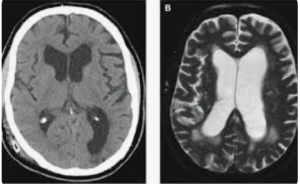In a observational case-control (probable iNPH vs. age‑matched healthy controls), force‑plate COP analysis Park et al. from the Kyungpook National University, Daegu, South Korea published in the journal Neurology and therapy to quantify static postural control abnormalities in Idiopathic Normal Pressure Hydrocephalus by assessing center‑of‑pressure (COP) metrics under eyes‑open and eyes‑closed conditions. Idiopathic Normal Pressure Hydrocephalus patients show significantly increased mediolateral sway and COP variability; anterior–posterior control is more vision‑dependent, suggesting direction‑specific balance deficits and potential for targeted rehabilitation 13).
In‑Depth Critique
* Scientific rigor:
-
Strengths: Objective force‑plate data; Bonferroni correction; clinically defined probable iNPH responding to CSFTT—a robust inclusion criterion.
-
Limitations: Modest sample size (56 iNPH vs 25 controls); cross‑sectional design precludes causality or post‑intervention implications.
* Data interpretation:
-
Clear demonstration of elevated mediolateral instability (vCOP, Std_vCOP, Dist_COP, BOS), particularly under EC—a convincing marker of intrinsic postural control impaired in iNPH.
-
Reliance on COP metrics in narrow frequency bands (0–0.5 Hz, 0.5–1.0 Hz) is reasonable, but the physiological origin of these oscillations could be better contextualized (e.g. vestibular vs somatosensory input).
* Clinical relevance:
-
Implications for tailored therapy: emphasize ML stability exercises (e.g., lateral weight shifts, stepping strategies) and incorporate visual–vestibular training.
-
The eyes‑open ML/AP ratio increase suggests visual dependence, reinforcing inclusion of reduced‑vision drills.
* Methodological caveats:
-
Force‑plate static stance may not reflect real‑world postural challenges (e.g., dynamic gait, perturbations).
-
Absence of intervention (e.g., post‑shunt evaluation) limits translation to treatment impact.
Final Verdict
This is a well‑executed observational study with sophisticated balance metrics, though limited by its scope and design. The findings reinforce clinical impressions and point to directionally tailored balance rehabilitation—but clinical trials are needed to confirm efficacy.
Rating
6.5 / 10 Rationale: Rigorous methodology and clinically relevant findings, but practical impact hampered by lack of dynamic testing and intervention data.
Takeaway for Neurosurgeons
iNPH patients exhibit pronounced mediolateral postural instability independent of vision and anterior–posterior instability that worsens with eyes closed—suggesting a two‑pronged balance rehab focus: strength/control in lateral plane and visual‑vestibular integration.
Bottom Line
This study objectively validates clinically observed direction‑specific balance deficits in iNPH—supporting development of bespoke balance training regimens targeting ML stability and sensory integration.
Publication date: July 13, 2025 Corresponding author: minys@knuh.kr
Park E, Kang K, Lee J, Lee JT, Park KS, Kim CH, Min YS. Characteristics of Postural Instability in Idiopathic Normal Pressure Hydrocephalus. Neurol Ther. 2025 Jul 13. doi: 10.1007/s40120-025-00786-y. Epub ahead of print. PMID: 40653591.
